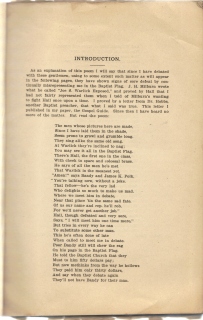While the occasional ‘First-Reads‘ posts have been far too few in number, I trust they have been of high quality. I am pleased to post this installment by Andrew C. Smith, Assistant Professor of Religion at Carson-Newman University in Jefferson City, Tennessee. A Nashville native, Andrew is a graduate of Carson-Newman, McAfee School of Theology at Mercer University and Vanderbilt University. I first met Andrew over five years ago when he came to DCHS to research for a seminar paper. A scholar of religious history, he is also a practitioner of denominational history and a committed churchman. I am pleased he consented to my request to compile this brief list of first-reads. Tolle lege!
—–
First Reads on Southern Baptists and the Southern Baptist Convention
1. C. C. Goen, Revivalism and Separatism in New England, 1740-1800: Strict Congregationalists and Separate Baptists in the Great Awakening. Waco, TX: Baylor University Press, 2012.
This is a reprint of a classic text originally published by Yale in 1962. Goen, perhaps better known to many as the author of Broken Churches, Broken Nation, shows how dissenting evangelical Congregational churches broke away from the Standing Order during the Great Awakening in New England. Eventually, three-quarters of these churches adopted adult believers’ baptism as a direct result of their conversionist convictions, creating a new “Separate Baptist” strain of credobaptism to the American religious landscape. Goen’s account of the emergence of the Separate Baptists remains the best, and helps to explain many American Baptist habits of thought and action.
2. Monica Najar, Evangelizing the South: A Social History of Church and State in Early America. New York: Oxford University Press, 2008.
Although not (yet) a classic among Baptist historians, Najar’s book (based on her dissertation) does much to explain the Baptist tradition of church discipline, offering some reasons that this tradition began to weaken in the years leading up to the Civil War. Najar believes that strong Baptist presence in the South led to an underdevelopment of Southern state governments owing to Baptist churches’ desire and ability to regulate their own members through discipline. At the same time, the debate over slavery proved impossible to resolve through those same disciplinary practices; churches ended up leaving the question of slavery to the state. This may well mark the beginning of the end of the tradition of church discipline among Baptists in the South.
3. Gregory A. Wills, Democratic Religion: Freedom, Authority and Church Discipline in the Baptist South, 1785-1900. New York: Oxford University Press, 1997.
On the topic of church discipline, I also recommend Greg Wills’ Democratic Religion: Freedom, Authority, and Church Discipline in the Baptist South. Wills’ approach to the rise and fall of the Baptist disciplinary tradition differs from Najar’s in that he is more concerned with issues of freedom and authority than he is in the relationship between Baptists and the state. The two volumes complement each other well.
4. William E. Ellis, “A Man of Books and a Man of the People:” E. Y. Mullins and the Crisis of Moderate Southern Baptist Leadership. Macon, GA: Mercer, 1985.
A Man of Books is one of those rare academic monographs that will still be worth a close read after thirty years on the shelf; in fact, Mercer now offers a paperback reprint edition. Although the book is cast as a brief biography of Southern Baptist leader E. Y. Mullins, the story really serves to illustrate the tensions between the SBC’s moderate leadership and its conservative rank-and-file pastors and ministers during the early 1900s.
5. Eighmy, John Lee. Churches in Cultural Captivity: A History of the Social Attitudes of Southern Baptists. With revised introduction, conclusion, and bibliography by Sam Hill. Knoxville: Tennessee, 1987.
Eighmy’s book is well-known among students of the Baptist tradition. His treatment of the social attitudes of Southern Baptists is probably the clearest articulation of the idea that Southern Baptists have been too close to their culture to question it in any significant way.
6. Bill Leonard, God’s Last and Only Hope: The Fragmentation of the Southern Baptist Convention. Grand Rapids, MI: Eerdmans, 1990.
Dr. Leonard’s volume is probably the best book written about the controversy that consumed the Southern Baptist Convention during the 1980s and 1990s. Although Leonard’s analysis is excellent, some will question whether his assertion that conservatives broke with longstanding tradition as they demanded that denominational employees affirm a doctrine of biblical inerrancy is fair or accurate.
7. Barry Hankins, Uneasy in Babylon: Southern Baptist Conservatives and American Culture. Tuscaloosa, AL: University of Alabama Press, 2003.
Hankins’ excellent book serves as a guide for those perplexed by the conservatives that have controlled the Southern Baptist Convention since the early 1990s. Hankins shows convincingly that many leading Southern Baptist conservatives were influenced by the views of Francis Schaeffer in part because they spent time outside of the south during their youths or young adulthood. Because of these experiences, these leaders came to believe that the Southern Baptist Convention should adopt a similar perspective as the South came to be less insular and began to assimilate to the cultural patterns of the rest of the nation.










